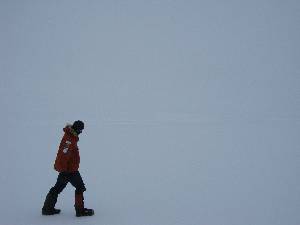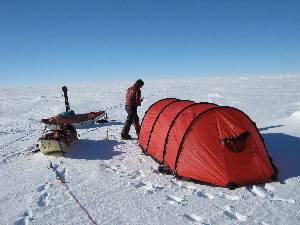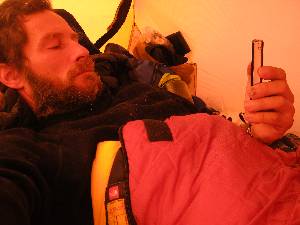Day 74–Searching for the Promised Winds
January 17, 2012
S86°12.067 W085°50.800
Elevation 5878 feet
We left early in the morning; and again late in the night. Both times, the winds defaulted on their promise. After barely one and a half hour of our slow moving morning session, balanced only by warmer conditions, the kites fell out of the sky, without ceremony. That was it for the first part of the day. We build up camp again, and rested for the day, until a slight flutter held more promise for our missing miles. I stepped outside. The sun was absent, and the landscape a sheet of white. I lifted my kite to confirm the threshold of wind. It flew. I hurried back in the tent, and woke Eric up. Our sleeping pattern is as erratic as the wind. We catch some when we can. We broke up camp again, laid out the kites. Then nothing. The temperamental flutter was gone. The air was still. No amount of running back would lift the nylon into the sky. We were marooned again. This last portion of the trip is losing its luster. Packing and unpacking the camp hardly qualifies as the epic long downwind days we had come to expect from previous accounts. Besides, we have seven days to complete mission, nine before we are pulled off the ice on the last flight out to Punta Arenas, Chile. In that time, we must cover 700 kilometers–699 to be precise!–and I am beginning to question whether we will be able to close. There is wind a degree or so below us, we just need to get there! Aside from that, we see more and more ondulations in these parts, and we are dropping in altitude like a lead balloon. We are over a mile below our POI elevation. The good news is, oxygen is plentiful around here and we are no longer sucking on air. Eric’s altitude cough, which was with him for almost two months, is gone. We barely managed 16.7 kilometers today; far from the 100 kilometers average we had set for ourselves. We are no longer likely to arrive early. Now we need to make that average, lest we get pulled off before completing. We are back to praying for winds. Perhaps I will have Eric repeat his wind dance; you never know. It seems to have worked the last time!
More




